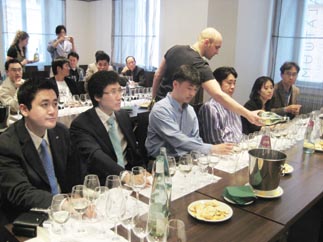Italian invasion going genuine, importers hope

Korean importers at a wine tasting during a product tour hosted by Buonitalia
To accommodate a growing market for Italian food, Buonitalia, an agency under the Italian Ministry for Agricultural and Forestry, recently invited a group of Korean importers of pasta, wine and canned tomatoes to a product tour of Italian food companies in Naples and Lazio, a region in central Italy that’s usually better known for its history and architecture.

Rummo, a famous Italian pasta factory near Naples
Indeed, the tour was a sign of Koreans’ growing fondness for Italian products.
By 2005 annual consumption of Italian food products in Korea was $10 million, or 9.8 percent of the local food market, according to the Korea Food Information Institute.
The figure rose by 45.8 percent in 2006 from the previous year, as the Korean market released restrictions on certain Italian products. Earlier this year the Italian Food Commission hosted a marketing promotion to celebrate the official import of prosciutto ham to Korea.
“Next to Japan, Korea is the fastest growing market in Asia for our pasta products,” says Giuseppe di Martino, the son of the founder of Di Martino, a famed pasta maker based in Gragnano near the Almafi Coast in southern Italy, an area with over 500 years of noodle history.
“If you go to Italian restaurants around the world they will have a menu full of pasta names with descriptions of their ingredients. But if their noodles are from Gragnano, the chefs will say that it’s from Gragnano on the menu, because it’s an indication that they are sticking to the authenticity of traditional pasta.”

A traditional Italian salumi from the Lazio region. Photos by Park Soo-mee
While Di Martino sells homemade pasta out of a small family-run business, Rummo, another pasta factory in Benevento outside Naples that the Korean team visited, is one of Italy’s largest pasta manufacturers with 130 employees and three major distribution centers (over 50 percent of Rummo’s sales come from outside Italy).
When South Korea starts free trade agreement talks with the European Union this month, local food exporters naturally expect the range of Italian imports to expand.
CJ Food System, one of the largest food importers in Korea, is currently selling chocolate, canned tomatoes and pasta from Italy in major discount stores and restaurants. The company’s next hot item is balsamic vinegar, which it is now working on acquiring.
“Small and medium companies in Korea began to import prosciutto as trade restrictions were lifted last year,” said James Jun, a merchandiser for international products at CJ Food System. “Currently the annual scale of Italian imports to Korea is around 27 million euros. Pasta is by far the best-selling product. But fresh handmade mozzarella is slowly spreading among Koreans nowadays. It is offered as an appetizer in Italian restaurants in the city. Panini has also slowly gained attention in coffee chains.”
Fresh tomatoes from Salerno, a key ingredient for famed Napoleon pizza, also caught the eyes of local importers.
San Marzano, the tomatoes grown by Campania on the vast plain of Salerno in an ideal Mediterranean climate, has been selected as one of the best brands of canned tomatoes in Europe.
Today Campania calls itself the “king of plum tomatoes,” after it obtained a Protected Denomination of Origin label in 1996 from the European Union for its processed product.
Italian wine from Lazio, which is slowly providing competition for French wine, is noted for the fresh water table under the region’s rich volcanic soil.
Lazio’s mild climate has led to abundant white wine production. Out of 535,000 hectoliters of wine produced in the region every year, 95 percent is white. Frascati and Marino are the leaders among the northern wineries of Lazio.
Franscati, in particular, has a storied history, once praised by the famous Roman poet G.G. Belli in his book of sonnets.
Wine, water and olive oil were all key products at booths during CIBUS Roma 2007, an Italian food fair, which the team visited last month at the Parma Exhibition Center in Rome.
“The local water market is relatively small at the moment,” said Julian Kim, an importer for De Cecco who is trying to import Fiuggi, the Italian medical water high in calcium served in Italian hospitals.
“We hope to put it on the market as early as this summer.”
By Park Soo-mee Staff Writer [myfeast@joongang.co.kr]










with the Korea JoongAng Daily
To write comments, please log in to one of the accounts.
Standards Board Policy (0/250자)